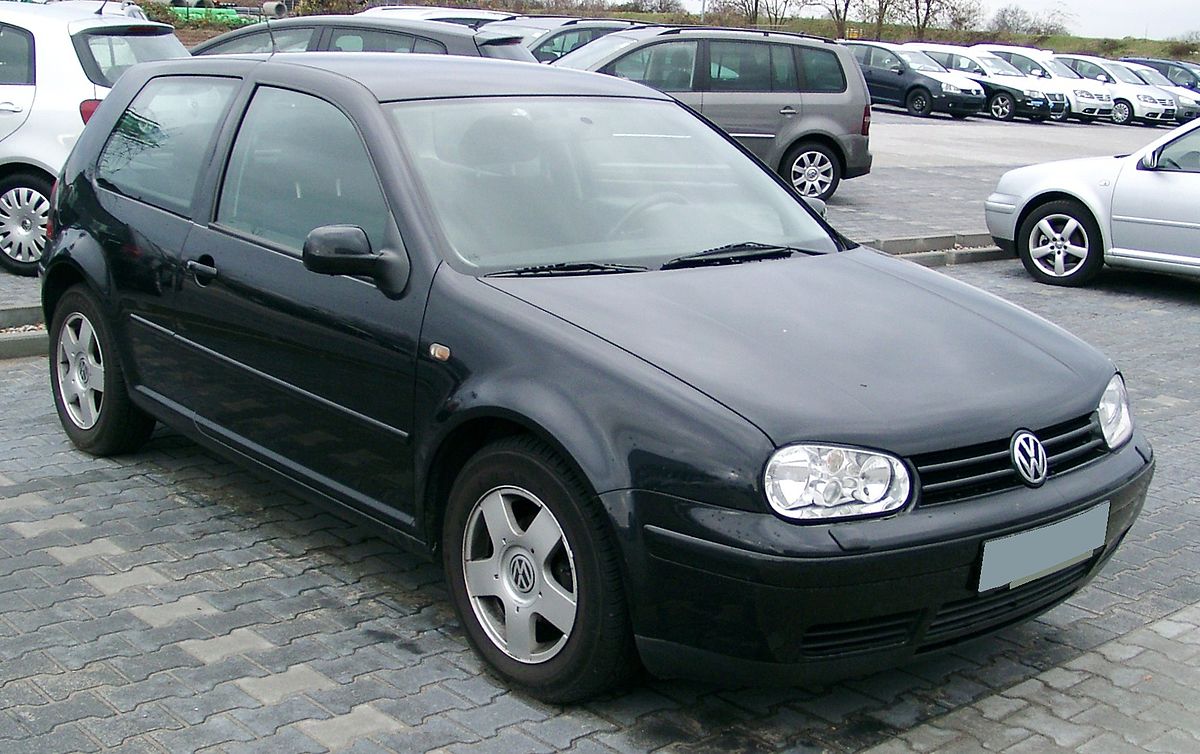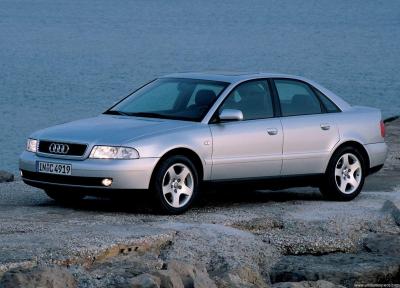
Volkswagen Golf IV
Not so long ago, the object of desire was the Golf IV, which, with reasonable equipment, was quite expensive for the people. Now things have changed a bit. The manufacturer releases new generations of Golfs so fast that they don't even have time to design a fresh body for them, and half the people on the street don't see the difference between them at all. The "Four", in turn, is aging and getting cheaper at the same time, which is why the period is approaching when it will take on Golf III - the driver of young show-offs at school.
In the offer of the Golf concern, it serves as a car for "normal people". Skoda Octavia is for the economical, Seat Leon is for the aesthetes, Audi A3 is for the wasteful. All these models use the A0 platform and differ in price, emblem on the hood and the egos of the drivers who drive them. The fourth generation Golf, in addition to the well-known 3d and 5d hatchback and station wagon bodies, also massively offered a sedan called Bora. It was such a luxurious edition of the Golf. Not only that, the proposal also included a convertible, but I have already devoted a separate article to it, and now there is no point in discussing it again. In a word - it has little in common with the fourth generation, and none of the brothers and sisters offered such a wide choice of bodies as the Golf. Volkswagen specs boasted that the quad had very small gaps in the body, proving its high rigidity and excellent driving performance. In fact, both were true. However, the Golf's main problem was the date of its birth - all class competitions: Astra, Focus and even Stilo were younger and knew exactly where to kick the German competitor so that he collapsed in pain. Its weak point was the A0 chassis - cool, but only half. The rear passengers were not spoiled, so the competition was much better in this regard. Likewise with the trunk.
Some slick marketer spearheaded Golf's career, got him to the top and took advantage of it. He knew that people would buy it, and demanded ridiculous money for what seemed to be a basic package - a second pair of doors, "electric", manual air conditioning ... it was not worth it, and people took it anyway. On the Polish market, the basic version had front airbags, power steering, ABS and… all standard. There was not even a central lock, because the Germans did not like us. The richer configurations fared better, but they were expensive and didn't indulge in elaborate extras. At present, it is probably best to download a used 5 from the West, because there you can find a lot of good things in it, but something for something - imported copies are often damaged. The equipment of the basic versions was hopeless, but the list of available options crushed the competition. You could order gems like Recaro sports seats, huge alloy wheels with the company logo, or navigation with a TV - today it may not be surprising, but then you could usually have something like that in a XNUMX-meter limousine or a sports convertible for half a million. But it was just a popular compact.
The Golf IV is one of the few cars with a particularly attractive diesel engine under the hood. At least for many buyers. The 1.9 TDI diesel available in this model created its own religion and was close to being declared a saint - such specimens are the easiest to sell, but also the most expensive to buy. Why? Just dust off the old Golf price lists of the late 90s - the weakest 90KM TDI cost as much as a trip to Pluto. How did he drive? He was still driving with a driver on board, not with his family. Best of all, you could still get the Golf IV with a 68-horsepower 1.9 SDI diesel engine - a little old, rather weak, accelerating to "hundreds" in a few months, but durable. However, it is best to be interested in one of the three diesels: 101 hp, 130 hp. and 150 hp They have pump nozzles, they shake and rumble, but they burn a little and are alive. 101km is a reasonable minimum for a 1.4th century compact, and the two more powerful options should cater to the tastes of people who like to feel more power under their right foot. Especially in this powerful edition. Other diesels either remember the Golf III era or break down more often than others - the choice is yours. It would seem that there is no point in writing about gasoline engines, but nothing could be more wrong - they are really cool. Several basic versions will appeal to calm drivers: 75 l 1.6 hp. too weak for this model, 100 l 105-1.6 hp will allow you to merge with the crowd, and in 110 liters 1.8 hp. FSI emblem. The 125L 2.0km and 115 1.8km round out the lineup for normal people - the higher engines I'd go for in a car like this. The 150-litre supercharged engine achieves between 180 and 210 hp. and after modifications it can be found in modern Volkswagen cars. Statement? This is a good engine. In general, only a turbocharger can break down in it, but thanks to it, the torque fluctuates between 235-2.3 Nm, and the car is really alive, especially when it jumps into revs. In addition, it burns a relatively reasonable amount of fuel. Similar power is achieved by the less common 150 hp - from 170 to 2.8 km, but it develops power differently and is actually more sluggish. Few people know that the honest Golf could also be equipped with a forked 204 liter engine with 3.2 hp, and the flagship 240 liter with 32 hp. in the R model. The latter configuration is a real gem, but unfortunately boring. Accelerates smoothly, practically does not slip - does not guarantee any unexpected emotions, fear for one's own life, side turns .... It simply reflects the character of this car, even despite its high power - the car can and does squeeze into the seat, but still power.
What about malfunctions? In this regard, the "four" is average. Usually the problems are caused by the “electrician” - power windows, the wiper mechanism, the light switch and the fuel gauge, which is lying to the living eyes. The brakes also wear out fairly quickly, and some vehicles may require steering gear regeneration. On the other hand, when it comes to the engine and units, there may be generator failures, leaky coolers, and diesel engines have problems with toothed belts. There is no point in discussing the topic of suspension, because in Poland even a tank would not be able to cope with it. Durability depends mainly on the roads on which the unit “shakes”, but usually the rubber and metal elements of the rear and front axles are the first to “fall”, especially the “rubber” bushings of the stabilizer and rear beam. The interior of the "four" is so gloomy that you can fall asleep in it, and its main problem is ripping off the cover from the handles on the doors and a few other elements. The manufacturer foresaw this, so the indicators are illuminated with a bright blue light, which at night stimulates the brain to suffer and the eyes to strain. Fortunately, there are versions on the market with a light finish on the lower part of the cockpit. However, it is impossible to hide the fact that the cabin is well soundproofed, the materials are really high quality and the ergonomics are almost perfect as standard. Only this is a smaller, correct mirror - probably, someone had a mania for introducing a new fashion and an exaggeration. With a lot of money, you could buy a lot of useful things and clean your bank account at the same time, but, fortunately, large, comfortable and resilient chairs come as standard. In addition, they are durable. The manufacturer already then offered interesting configurations, so you won’t surprise anyone with a “naked” Golf with heated seats and headlight washers. Be that as it may, Volkswagen's standard equipment policy has not changed much even after a few years. It's cramped in the back, but short people shouldn't complain. The luggage compartment also does not break capacity records - the hatchback has at least 330 liters, and the wagon has 460. It is exceptionally slim, adjustable and well finished, but there is one catch - the Golf IV can be purchased in the 4motion version, i. driven by four legs. The transfer of the rear axle worsened driving performance and occupied some space, due to which the luggage compartment was sharply reduced - the hatchback had only 245 liters.
True, more or less since the Golf IV, Volkswagen compacts have ceased to be cars for the people, but due to the fact that the latest generations are produced with the frequency of Poles leaving for work “in the dishwasher”, the “four” “is not expensive - although still more expensive than competitors. Maybe because it's a really good car. Driving such a Golf to school is something, but on the streets - well, the manufacturer himself confirmed with his advertising slogan what kind of car it really is - “das auto” and that’s it.
This article was created thanks to the courtesy of TopCar, who provided a car from the current offer for a test and photo session.
http://topcarwroclaw.otomoto.pl
st. Korolevetska 70
54-117 Wroclaw
Email address: [email protected]
tel: 71 799 85 00

